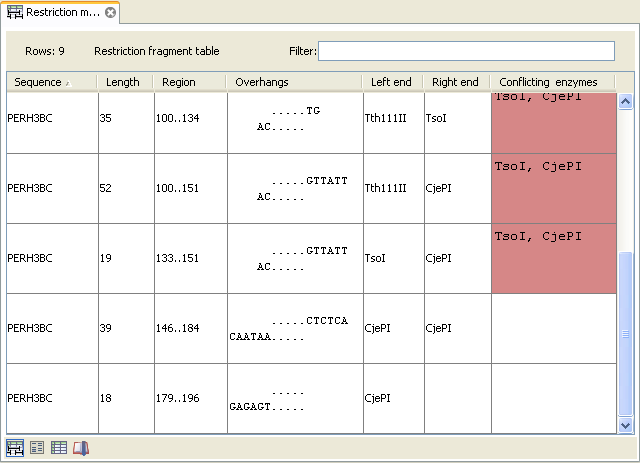Table of restriction fragments
The restriction map can be shown as a table of fragments produced by cutting the sequence with the enzymes:
Click the Fragments button
(![]() ) at the bottom of the view
) at the bottom of the view
The table is shown in see figure 29.46.

Figure 29.46: The result of the restriction analysis shown as annotations.
Each row in the table represents a fragment. If more than one enzyme cuts in the same region, or if an enzyme's recognition site is cut by another enzyme, there will be a fragment for each of the possible cut combinations 29.3. The following information is available for each fragment.
- Sequence. The name of the sequence which is relevant if you have performed restriction map analysis on more than one sequence.
- Length. The length of the fragment. If there are overhangs of the fragment, these are included in the length (both 3' and 5' overhangs).
- Region. The fragment's region on the original sequence.
- Overhangs. If there is an overhang, this is displayed with an abbreviated version of the fragment and its overhangs. The two rows of dots (.) represent the two strands of the fragment and the overhang is visualized on each side of the dots with the residue(s) that make up the overhang. If there are only the two rows of dots, it means that there is no overhang.
- Left end. The enzyme that cuts the fragment to the left (5' end).
- Right end. The enzyme that cuts the fragment to the right (3' end).
- Conflicting enzymes. If more than one enzyme cuts at the same position, or if an enzyme's recognition site is cut by another enzyme, a fragment is displayed for each possible combination of cuts. At the same time, this column will display the enzymes that are in conflict. If there are conflicting enzymes, they will be colored red to alert the user. If the same experiment were performed in the lab, conflicting enzymes could lead to wrong results. For this reason, this functionality is useful to simulate digestions with complex combinations of restriction enzymes.
If views of both the fragment table and the sequence are open, clicking in the fragment table will select the corresponding region on the sequence.
Footnotes
- ... combinations29.3
- Furthermore, if this is the case, you will see the names of the other enzymes in the Conflicting Enzymes column
